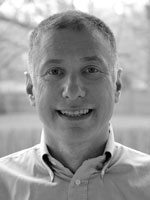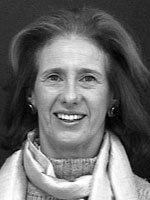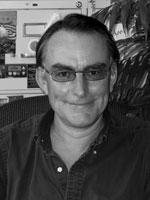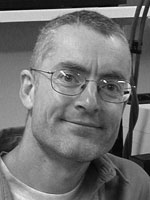 |
 |
|
 |
 |
 |
 |
 |
|
 |
 |
 |
 |

An electronic newsletter from the Marine Biological Laboratory
Back to index
The MBL Corporation elected five new members to the MBL Science Council
The MBL Corporation elected five new members to the Science Council. Larry Rome (University of Pennsylvania) will represent the Whitman Center; Peter Smith (MBL Molecular Physiology Program), Barbara Furie (Harvard University), and Christopher Neill (MBL Ecosystems Center) will represent Resident Research Centers and Programs; and Timothy Mitchison (Harvard University) will represent Education.
 |
|
Dr. Lawrence C. Rome received his A.B. from Dartmouth College and his Ph.D. from Harvard University in 1981. Currently Dr. Rome is a professor in the Biology Department at the University of Pennsylvania. Dr. Rome studies the design of muscular systems from the molecular level (e.g., rapid Ca2+ movements in superfast toadfish muscle) to the whole animal level (e.g., kinematics of swimming scup.) Recent work on humans has included the design of electricity-generating and ergonomic backpacks for which Dr. Rome has had one patent issued and several others pending. Dr. Rome first came to the MBL in 1976 as a student in the Invertebrate Zoology course. He returned in 1986 as a MBL Summer Fellow and has had a lab at the MBL every summer since (except two). Dr. Rome has also spent two sabbaticals in Woods Hole and was a visiting investigator at WHOI. |
|
|
 |
Dr. Barbara C. Furie is an Adjunct Scientist at the MBL and Professor of Medicine at Harvard Medical School. She received her B.S. from New York University and her Ph.D. from the University of Pennsylvania. Dr. Furie established a laboratory at the MBL in 1996 to study the synthesis and role of g-carboxyglutamic acid in marine organisms. She has served on a number of MBL committees including the Science Council Nominating Committee, the Summer/Visiting Research Programs Task Force and the Funding/Finances Task Force during the MBL’s recent strategic planning initiative. She has also served on the Executive Committee of the MBL Director/CEO Search Committee. |
|
|
 |
Dr. Christopher Neill holds a B.S. from Cornell University and a Ph.D. from the University of Massachusetts. He came to the Ecosystems Center as a post-doctoral associate in 1991 and has been a member of the Ecosystems Center scientific staff since 1997 where he is now an Associate Scientist. Dr. Neill’s research focuses on understanding how changes in land use and other human activities alter the structure of ecosystems. In Brazil, he investigates how clearing of Amazon forest alters soil nutrients, the emissions of carbon dioxide and nitrogen oxides from soils to the atmosphere and the chemistry and ecological structure of streams and rivers. Dr. Neill is a faculty member in the MBL’s Semester in Environmental Science and holds a joint appointment in Ecology and Evolutionary Biology at Brown University. He currently chairs the Ecosystems Center Facilities Committee and serves on the MBL Buildings and Grounds Committee. He has co-directed the environmental section of the MBL Science Journalism Program since 2000. |
|
|
 |
Dr. Peter J.S. Smith is the director of the Molecular Physiology Program and the BioCurrents Research Center (BRC) at the MBL. The BRC has been competitively funded under his direction since 1996 and is a resource center of the National Institutes of Health (NCRR). The core of Dr. Smith’s research is the study of cellular dynamics with a particular emphasis on the transport of ions and molecules using advanced electrochemical and imaging approaches. He hosts over 30 visiting scientists each year collaborating on a wide range of subject from biomedical and basic biology. (The research activities of the group as a whole can be viewed at www.biocurrents.org). He has served as a member of several NIH Study Sections since 2001 and he has served previously on the Science Council. He is the current chair of the Children’s School of Science, Optics Committee. Dr. Smith received his Ph.D. from Aberdeen University in Scotland studying cephalopod cardiovascular physiology. Prior to coming to the MBL in 1992, he was a senior scientific officer at the AFRC Laboratory of Molecular Signaling, University of Cambridge and a Fellow of Sidney Sussex College. He was a Leverhulme Research Fellow in Cambridge from 1985 to 1988. He has been a member of the MBL Corporation since 1992. |
|
|
 |
Dr. Timothy J. Mitchison graduated from Merton College, Oxford, UK in 1980 with a B.A. in biochemistry. In 1984 he received his Ph.D. from the University of California, San Francisco in biochemistry and biophysics. He was a Searle Scholar from 1989 to 1992; a Packard Research Fellow from 1988 to 1993; and was a Fellow of the Royal Society in 1997. Dr. Mitchison has worked for 20 years on the mechanism of cell division, and has made major discoveries on how the mitotic spindle is built and how chromosomes move. He is also an expert in drug discovery. He led the Harvard Institute for Chemistry and Cell Biology for seven years where he focused on discovery of new drugs that block cell division, and development of new technology for drug discovery, notably automated microscopy. His laboratory is experienced with high-throughput screening technology, and Mitchison advises a major pharmaceutical company on cell division drugs. He is now Deputy Chair of the new Department of Systems Biology, and chair of the steering committee for ICCB-Longwood, the Harvard Medical School facility for high-throughput screening of RNAi and small molecule libraries. Dr. Mitchison has served as a member of Science Council for the past three years. |
|
|
Back to top
copyright © 2006 by The Marine Biological LaboratoryTM
|
|
|
|
|

|
| |
 |
|
 |
 |
|